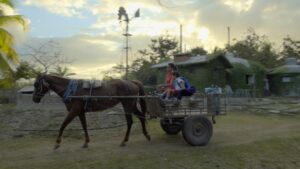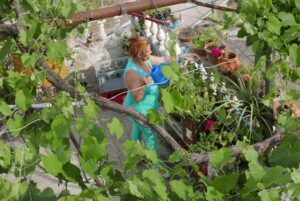Creating Local Food Systems Can Defeat Industrial Food Corporations
By Sharanya Sanil Kumar
With egg prices soaring, late-night comedian Jimmy Kimmel recently took to Hollywood Boulevard to ask passersby how birds have babies. You can imagine, it got funny. People’s knowledge of birds and bees stuff was hilarious as was the common sense stuff like, where do our meals come from? Each vegetable, lentil, and egg has made a heroic journey to reach your plate. Make no mistake, the birds and the bees got in on the action – but, as you can imagine, for something so natural and simple, it’s complicated. These questions led me to explore more about locally sourced food and local food systems that are shaping our communities.
Yes, supermarkets are more convenient, aren’t they? The common people are stuck in a rat race, and fast-paced lives, and picking up groceries from the all-in-one place conveniently allow us to splurge on products that potentially deplete our environmental resources. Now we are witnessing an age that needs to gain more traction such as community agriculture. It requires fundamental beliefs to be broken down and restructured to reimagine the way we feed ourselves and the environment.
The recent film “Saving Walden’s World” zeroed in on examples of permaculture and agroecology being practiced in Cuba, Slovenia, rural Maine, and my home state of Kerala in southern India. Far from utopias, all these societies have challenges, yet, implemented agrarian reforms in the 50’s that democratized the access to arable land. Rural communities are often left behind, however, the film captures a certain poetry that transpires when generations of farmers have access to land, knowledge, and markets. This intergenerational wealth breaks the cycle of poverty while ensuring food is healthy, safe, and available, regardless of global market instability.

Beyond the Farmers Market
The local food movement isn’t just about colorful stalls at the weekend farmers market. It also means creating community agricultural lands where we invest directly into the farms and food co-ops. The community itself being the buyers and investors will give them the decision-making power on how the food is grown and what goes into it.
When communities invest in local food systems, they gain more than just nutrition. They build resilience against supply chain disruptions that we’ve all experienced in recent years. They create jobs that cannot be outsourced. They keep money circulating within the local economy. Perhaps most importantly, they preserve agricultural knowledge that might otherwise disappear from our collective memory.

Breaking Dependency on Industrial Agriculture
Our current local food system hinges on massive farming operations, lengthy supply chains, and corporate distributors. This system, though convenient, has delivered abundance at significant costs. They are largely responsible for soil degradation, water pollution, vulnerable supply chains, declining rural economies, and a growing alienation from natural food sources.
Local agricultural communities, however, offer an alternative path. Many small-scale farms producing diverse crops for nearby markets significantly reduce transportation emissions while providing fresher food. They often carry out regenerative practices that build soil health rather than depleting it. These farms create impactful work and give a whole new meaning to strengthening communities.
Tom Jackson, a local farmer, transformed five acres outside Burlington into a thriving market garden. He explained it perfectly: “When you buy directly from your neighbor who farms, you’re not just getting better food. You’re voting for a different kind of community—one where we depend on each other rather than distant corporations.”
Advancing Food Autonomy
The local food movement is built on a foundation of regaining control over how communities feed themselves. Food-sovereign communities are those who have power over their agricultural systems rather than being dictated by distant market forces or government policies.
This independence doesn’t happen overnight. It requires developing detailed elements, such as –
- Land access programs that help new farmers acquire affordable agricultural land
- Processing facilities where raw farm products can be transformed into marketable goods
- Local distribution networks that connect local producers with nearby consumers
- Education initiatives that pass farming knowledge to new generations
- Supportive policies at local and regional levels
Communities that help invest in these elements create not just food security but food democracy! It will grow to be a place where citizens actively shape their food system rather than passively consume whatever appears on store shelves.
Stories Beyond Theory
Let’s look at a few communities that have already demonstrated how local food systems work in practice.
Hardwick, Vermont is a small town of just 3,000 residents and has created a thriving agricultural economy centered around local production. Farmers, food producers, and residents formed collaborative networks that have revitalized the town’s economy while providing healthy food access.
Urban areas are also finding their paths back to local food systems. In Detroit, the people have transformed neighborhood gardens (vacant lots) into productive green spaces that feed residents while building community. The city now has over 1,500 urban farms and gardens producing food where grocery stores are scarce.
Even suburban communities are reimagining themselves. In suburban Denver, the Highlands Ranch community converted extensive portions of its landscaping into productive food gardens managed collectively by city residents. This helped significantly reduce their dependence on imported produce.
Challenges and Realistic POV
Building an independent agricultural community comes with its fair share of hurdles. The main three points of concern are –
- Local production leads to higher labor costs.
- Seasonal boundaries often affect year-round availability in many regions.
- Small producers struggle to achieve industrial agricultural efficiency
The answer isn’t abandoning global food production entirely, but creating a more balanced ecosystem where communities produce what makes sense locally while thoughtfully sourcing their other needs.
Claire Miller, who runs a regional food hub in western Massachusetts, takes a practical view that resonated with me: “We don’t pretend we can grow everything here. But we can grow much more than most people realize, and doing so makes our community stronger.”
The Starting Line
We don’t expect communities to be able to transform overnight. The journey towards agricultural independence can begin with even the smallest steps.
Here are a few beginner-friendly steps to start with –
- Start supporting existing local farmers through direct purchasing
- Advocate for policies that protect farmland from development
- Learn to grow small amounts of food in your backyard!
- Get involved in community garden initiatives
- Develop food preservation skills that extend seasonal bounty!
Each bit of action builds an ever-growing bank of knowledge and connection, in turn, reinforcing the local food systems.
The Bigger Picture
When communities rebuild local food systems, they create models others can follow. This allows them to demonstrate alternatives to industrial agriculture which can be adapted to different regions. This will ignite efforts to connect with larger movements of sustainability, economic justice, and community resilience. By reclaiming control over something as fundamental as food, communities develop skills and relationships that strengthen their ability to address other challenges.
Local food systems aren’t just about what’s on your plate—it’s about who controls the system that nourishes you, your family, friends, and neighbors.
As we face climate uncertainty, supply chain vulnerabilities, and economic instability, the communities investing in their agricultural independence aren’t just preparing better meals but better futures. The narrative of food is changing, and we all have a role in writing its next chapter.
About Author – Sharanya Sanil Kumar
Sharanya Sanil Kumar is the Publicist and Impact Producer for Saving Walden’s World. She is passionate about sustainability, women’s empowerment, and community-driven change, using storytelling to inspire action. She lives with her family in Kochi, Kerala.


One Response